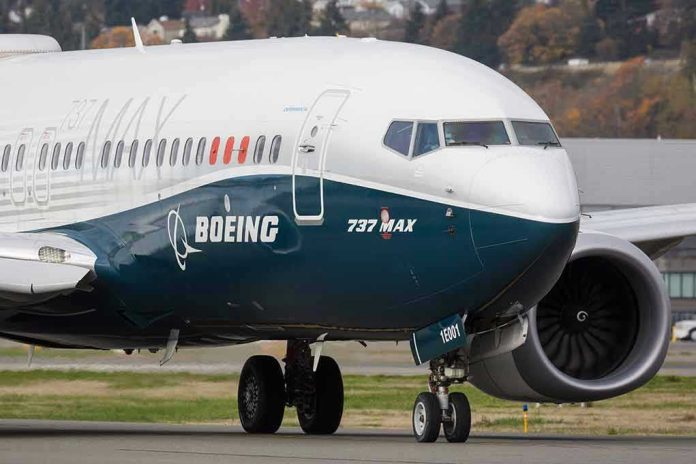
Boeing’s $4.9 billion hit on its 777X program isn’t just a number—it’s a flashing red warning light for the future of American aerospace dominance, and a boardroom drama with billions at stake.
Story Snapshot
- Boeing recorded an unprecedented $4.9 billion charge on its 777X jet, slashing quarterly earnings and rattling investors.
- The charge spotlights persistent delays and regulatory obstacles haunting the 777X, Boeing’s flagship widebody aircraft.
- This setback amplifies the aftershocks of the 737 MAX crisis and places Boeing’s rivalry with Airbus on a knife’s edge.
- Airlines, suppliers, and thousands of jobs are caught in the crossfire, with ripple effects across the global aviation industry.
Boeing’s Billion-Dollar Blow: What Went Wrong With the 777X?
On October 29, 2025, Boeing stunned the market by announcing a $4.9 billion pre-tax charge tied directly to its trouble-plagued 777X program. The company’s Q3 financial results revealed a loss per share of $7.14, a direct result of this colossal write-down. The culprit: “updated 777X certification timing.” Translation? The world’s largest aerospace company finds itself once again at the mercy of regulatory scrutiny, engineering setbacks, and ballooning costs, echoing the very storms that battered its 737 MAX fleet.
Wall Street responded with the jitters you’d expect when a blue-chip icon admits a multibillion-dollar misstep. Boeing’s executives faced tough questions about whether the 777X, billed as the future of long-haul aviation, is turning into a cautionary tale of overreach and missed deadlines. The magnitude of the hit is among the largest in Boeing’s history, and it drives home just how high the stakes have become for this program’s survival.
How Did Boeing Get Here? A Timeline of Delays and Disruption
The 777X story began with promise in 2013: a next-generation widebody with new GE9X engines, composite wings, and advanced aerodynamics, aimed squarely at dethroning Airbus’s A350. But the dream quickly tangled with reality. Technical glitches, supply chain woes, and, most damning, a regulatory environment forever changed by the 737 MAX tragedies, conspired to drag out certification timelines. COVID-19 threw jet fuel on the fire, upending demand and production. Each delay meant more money burned and more patience tested—among airline customers, suppliers, and the FAA alike.
Regulatory agencies, especially the FAA, now hold an iron grip on the process. Their hesitation is understandable: after the 737 MAX, no one is eager to greenlight a new jet without exhaustive scrutiny. Airlines like Emirates and Lufthansa, who bet big on the 777X, are left recalculating their fleet plans. Suppliers from GE Aviation to Spirit AeroSystems, already battered by pandemic-era shocks, now face more uncertainty and, potentially, lost contracts. The web of stakeholders grows more tense with every quarter the 777X remains grounded.
The Ripple Effects: American Industry, Competition, and Credibility at Risk
The immediate damage is measurable: a mammoth charge against earnings, nervous investors, and a production schedule in limbo. But the deeper wounds may be harder to heal. Boeing’s reputation—already battered—takes another hit, making it that much harder to win back public and regulatory trust. Rivals at Airbus are quietly celebrating, as every delay in Seattle hands them a wider lead in the lucrative widebody market. For American manufacturing, the risks are existential: every lost sale, every delayed delivery, means jobs at risk and communities in limbo.
The political dimension is impossible to ignore. Lawmakers and regulators, conscious of the fallout from past failures, are keeping Boeing on a short leash. The FAA’s leverage is unprecedented, and the relationship between regulator and regulated has shifted—perhaps permanently. Airlines, for their part, may demand concessions, compensation, or even cancellation, putting further pressure on Boeing’s already strained finances. Suppliers, too, may look to diversify to protect themselves from further shocks.
What Happens Next? Uncertainty, Opportunity, and the Long Road to Redemption
Boeing’s own statements offer little comfort: there’s no revised entry-into-service date for the 777X, only a pledge to review production and delivery schedules. The company’s order backlog remains strong—$636 billion across programs—but confidence is a fragile asset. Analysts broadly agree the $4.9 billion charge is a necessary moment of transparency, a clearing of the decks before the next act. But some warn the true costs may climb even higher if regulatory hurdles persist or if airlines lose faith.
The stakes are clear. For Boeing, this is about more than a quarterly loss; it’s about the future of its leadership in the global aerospace market and its ability to compete with Airbus. For American workers, it’s about jobs and industrial security. For travelers, it’s about the planes that will carry them across oceans for decades to come. The next chapters will be written not just in boardrooms, but in the halls of regulatory agencies, on the assembly lines of suppliers, and in the waiting rooms of airline executives worldwide. One thing is certain: the world is watching, and Boeing’s every move now matters more than ever.
Sources:
Boeing Reports Third Quarter Results
Boeing Investor Relations Q3 2025 Press Release












